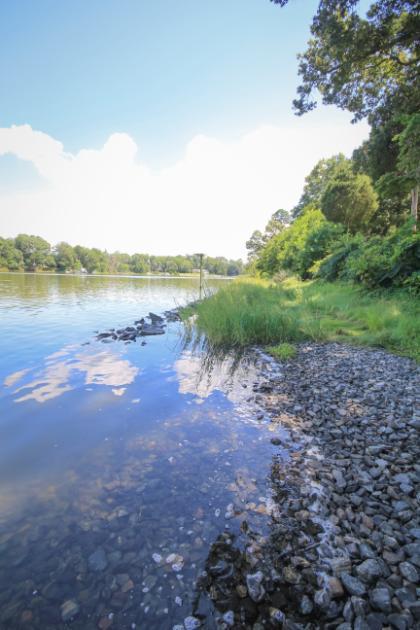
Shoreline Erosion & Habitat Research Project

The Baliles Center is a leader in experimental living shoreline technologies to stabilize shoreline and create wildlife habitat. The Baliles Center has installed an award-winning living shoreline marsh and sill that serves as a demonstration site for the public, contractors, wetland board members, and the ecological restoration community.
This research and educational project was supported by grants from the National Oceanic and Atmospheric Administration (NOAA) through the National Fish and Wildlife Foundation (NFWF) and support from the Longwood University Foundation. It involved the expertise of many partners including Virginia Institute of Marine Science (of the College of William and Mary), Virginia Commonwealth University, Longwood University professors & undergraduate researchers, David Burke (of Burke Environmental Associates LLC), NOAA, Northern Neck Planning District Commission, Northern Neck Soil & Water Conservation District, Clean Virginia Waterways and community volunteers.
The Baliles Center has approximately 8,400 feet of shoreline along Glebe and Aimes Creeks, some of which is subject to extensive erosion. In 2005 and 2006, the Farm launched a Living Shorelines: Shoreline Erosion Control and Habitat Research Project. Longwood secured a grant to assess how living shoreline techniques could be used on-site to control erosion, while also preserving or restoring shoreline habitat that supports shorebirds, juvenile fish, tidal marsh, submerged aquatic vegetation, and other plant and wildlife species.
Living shoreline techniques offer a biologically sensitive alternative to bulkheads and other "shore hardening" structures, which are expensive, temporary and damaging to shoreline habitat. In years past, fewer "soft" shoreline stabilization alternatives were available and landowner awareness of the need for improved shoreline management practices was lacking. As a result, landowners relied upon traditional erosion control techniques such as bulkheading and riprap revetments. Further, intensive structural treatments were often used in protected coves and embayments where erosion threats were minor or non-existent. In recent years, a growing number of landowners are investigating living shoreline protection alternatives and retrofitting previously hardened shorelines by creating fringe marshes in front of existing structures.
The project included an inventory of the existing shoreline for the Baliles Center as well as the entire Lower Machodoc Creek. Potential locations for a variety of shoreline management treatments (including living shorelines) were identified, and workshops and educational seminars on living shoreline designs were held for local residents.
Two Longwood professors (Drs. Mark Fink and Tom Akre) and under-graduate research assistants spent the summer of 2007 collecting data as part of a long-term research project that will examine the effectiveness of the sill/fringe marsh management technique at maintaining and/or restoring the aquatic biotic community. Research continued in 2008-09 after the marsh and sill were installed. Undergraduate research is under the direction of Dr. Fink, and has received support from the Virginia Coastal Zone Management Program (with funds from NOAA).
In 2007, Longwood won an additional grant from NOAA’s Living Shoreline Grant Program to cover most of the costs of the sill and fringe marsh installation. The sill is now in place, and the marsh grasses, planted by community volunteers, are thriving. In late 2008, the project's contractor, Earth Resources Inc of Lancaster County was awarded the Ecological Excellence Award from the Virginia chapter of the Soil and Water Conservation Society.
Related Links
Living Shorelines Workshops: Longwood University’s Hull Springs Farm in conjunction with the Center for Coastal Resources Management (part of the Virginia Institute for Marine Science) presented two Living Shorelines workshops at Hull Springs Farm.
- The Virginia Institute of Marine Science has extensive information about Living Shorelines.
- Virginia Department of Environmental Quality's Coastal Zone Management Program also has great Living Shorelines information.
